The Impact of Artificial Intelligence in Information Technology

Businesses rely more on artificial intelligence in information technology as systems grow larger and harder to manage. Many teams still struggle to unlock the full application of artificial intelligence in information technology, especially when facing data overload and rising security demands. This MOR Software’s guide will help you understand what matters most and where AI in information technology creates real impact.
What Is The Role Of AI In The Information Technology Industry?
Research firm IDC projects that worldwide spending on technology to support AI strategies will reach 337 billion dollars in 2025 and more than double by 2028. This shows how deep machine learning is entering everyday IT work.
The role of artificial intelligence in information technology is to help computers handle tasks that once depended on people. These systems rely on machine learning models and algorithms to work with data. Through this approach, AI and machine learning create tools that can act in ways that feel similar to human decision making. This also connects well with how AI in information technology continues to support daily IT operations.
Consider a system built to monitor network activity. It can detect strange patterns in a short time. This allows IT teams to respond fast to possible risks before they grow. This early action helps prevent major interruptions and protects business systems from damage. These abilities help keep IT environments stable.

AI tools also support customer service teams with constant assistance. They take care of simple tasks like password resets or pulling basic information. They can shift harder issues to human agents when needed, which keeps support running smoothly without delays. This makes the platform helpful for both users and service staff in the IT field.
AI systems can also adjust and grow over time because they learn from each interaction. They improve their answers as they process more data. This shortens response times and builds a more personal customer journey. As the platform collects more feedback from users, it changes the way it responds to fit each person better. This ongoing learning cycle highlights how AI in IT field continues to shape modern IT experiences. The 2025 AI Index from Stanford reports that 78% of organizations used AI in 2024, up from 55 percent the year before. This shows how quickly this learning power is moving into real IT work.
Core Technology Areas Within AI
AI works as a broad field that includes several major technology groups. These groups include machine learning, deep learning, natural language processing, image processing, and speech recognition. Among them, the strongest influence in IT often comes from machine learning and deep learning because they support many core functions that drive AI in computer science and modern IT systems.

Machine Learning
Learning sits at the heart of intelligence. Machine learning works as a branch of AI automation that trains a program to read data through defined algorithms. This type of system can adjust its own output without human help, using the data it has processed. With ML methods, a machine gains the ability to study large datasets and then carry out specific tasks based on what it has learned. This foundation also shows the role of information technology in artificial intelligence since IT provides the systems needed for training and data handling.
Deep Learning
Deep learning is another part of ML that uses similar methods but offers greater capability. In this approach, a computer is trained to complete classification tasks using sounds, text, or images. It relies on large sets of labeled data and neural network designs to reach this level of accuracy. These structures help the platform process complex information and return more precise results.
Natural Language Processing
Natural language processing helps AI read and work with human language. It lets computers understand written text or spoken words with more ease. NLP depends on two main ideas, Natural Language Understanding and Natural Language Generation. These engines support chatbots and virtual assistants so they can interact with users. NLP also strengthens sentiment analysis tools used in IT, which helps companies read customer opinions more effectively.
Computer Vision
Computer vision gives AI the ability to study and interpret visual content like photos or videos. With this information, the system can respond with actions or suggestions. If AI diversity supports a computer's ability to think, computer vision gives it the ability to view and understand what it sees. This closes the gap between digital information and real-world visuals, helping the platform make better decisions across different tasks.
Challenges Facing The IT Sector Today
The IT sector deals with many ongoing issues that affect daily operations and long-term planning. These challenges also shape how teams use modern tools, including AI in IT field, to stay effective. Many of these issues now push companies to adopt artificial intelligence in information technology so they can manage systems with more accuracy and speed.
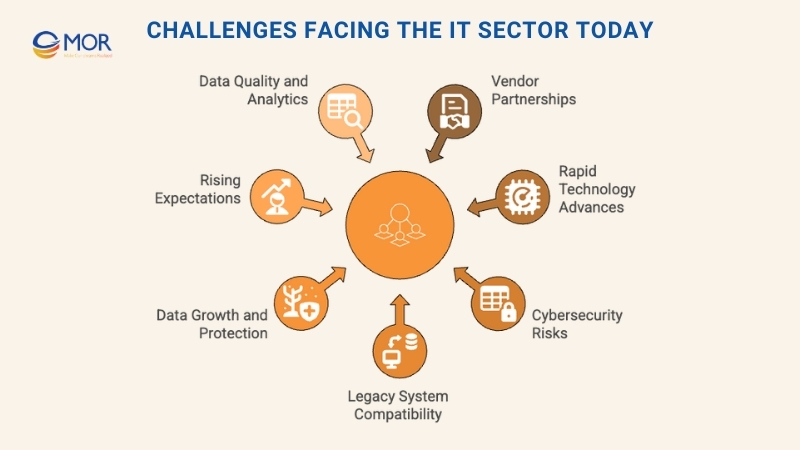
Vendor Partnerships And Contracts
IT teams must manage vendor relationships with care. Contract discussions and service level reviews often require careful attention. The industry changes quickly, and new tools appear all the time, so vendor agreements need steady oversight and clear planning. Strong coordination helps companies stay aligned with the pace of technology.
Rapid Advances In Technology
In KPMG's Global Tech Report 2024, 81% of technology leaders said it is difficult for their business to keep up with the pace of change. This matches this constant pressure in IT.
Technology shifts fast, and this creates pressure for constant learning and adjustment. Tools linked to AI, cloud platforms, IoT devices, and generative AI in cyber security keep growing. IT service teams invest large amounts of time and resources in research and development so they can deliver solutions that match client needs. This continuous effort ensures they can respond to new trends in the market.
Cybersecurity Risks
Cyber threats grow more advanced each year. IBM's 2024 Cost of a Data Breach report found that the average breach now costs 4.88 million dollars worldwide. Therefore, a single attack can cause serious damage to any organization.
Malware, ransomware, phishing attacks, and unknown vulnerabilities all create serious risks. Staying prepared is a demanding task. IT teams must remain alert and use fresh security methods to keep systems safe.
Legacy System Compatibility
Many companies still rely on old legacy system while also bringing in new technologies. Connecting both environments is difficult. Teams must support new features without breaking existing workflows. This balancing act often requires careful planning and detailed technical knowledge.
Data Growth And Protection
Data continues to expand quickly, which raises concerns about management and safety. Research summarized by DemandSage shows that the world is expected to generate about 181 zettabytes of data in 2025. This explains why data protection has become so challenging.
Protecting sensitive information is essential for every business. Meeting privacy rules and preventing breaches are ongoing responsibilities. These tasks require strong processes supported by reliable artificial intelligence information systems and secure IT practices.
Rising Expectations From Employees And Users
People expect more from IT teams today. They want flexible, personalized, and scalable tools that support their tasks. A recent study run for HP found that white-collar workers lose around 51% of their workday to repetitive, low-value tasks. And 70% of IT leaders say they plan to roll out integrated AI tools within the next year to help.
They also look for quick responses, full service coverage, and stable support. Meeting these expectations means teams must stay flexible and responsive to change.
Maintaining Strong Data Quality And Analytics
Organizations need accurate data and strong analytics to make better decisions. A survey published in MIT Sloan Management Review reported that only 37.8% of companies had created a data-driven organization even though 98.8% were investing in data initiatives. This highlights how hard it is to turn raw data into real value.
Handling large datasets and finding clear insights can be difficult. Teams need advanced skills and the right tools to work with growing data demands. High-quality analytics help guide smarter actions and support long-term goals.
How AI In Information Technology Helps Solve These Challenges
The IT sector deals with many barriers, yet AI provides clear ways to reduce these pressures and improve daily work across teams using AI in tech to handle tasks faster and with more accuracy.
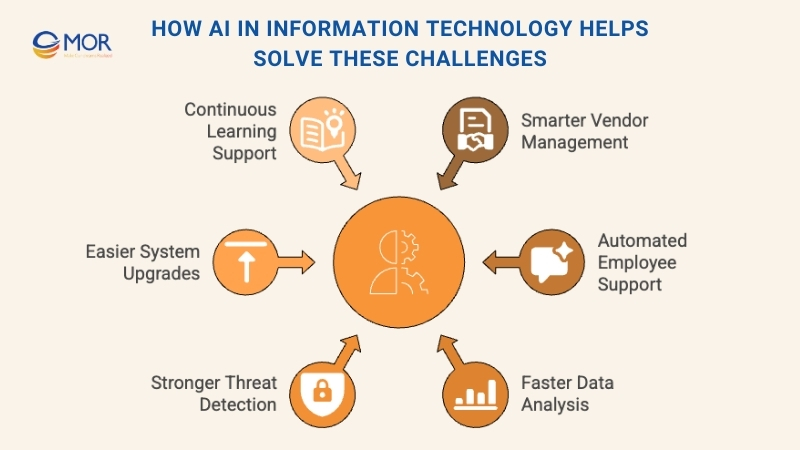
Smarter Vendor Management
AI helps improve vendor oversight through automated contract checks and smarter review tools. Predictive analytics give teams a clearer view of vendor performance. These abilities save time and improve accuracy, which makes vendor management easier and more reliable. This reflects how artificial intelligence in information technology supports stronger decision making in everyday operations.
Automated Employee Support
AI chatbots and virtual assistants can answer simple questions from employees at any time. This gives human staff more time to solve harder problems. These tools ensure workers always receive quick help, which raises satisfaction and improves support quality across the organization.
Faster Data Analysis
Machine learning models and predictive analytics tools increase the speed of data review. They help teams find patterns and learn from large datasets. This leads to better insights and stronger decisions based on real information sets used in machine learning. These improvements help businesses stay competitive and act with confidence.
Stronger Threat Detection
AI strengthens fraud detection systems because it can study older records and find patterns linked to fraud. It can flag suspicious activity in real time. Research compiled by security company Cobalt notes that 74% of IT security professionals say their organizations are already feeling significant impact from AI-powered threats. So fast, automated detection is becoming essential.
These systems also watch user behavior to detect unusual actions that might signal a risk. This gives companies stronger protection and reduces the chance of damage.
Easier System Upgrades And Integration
AI helps teams connect older systems with new tools more smoothly. Machine learning can study how legacy apps are built and map their structure. This makes integration faster and helps companies upgrade systems without slowing down operations.
Continuous Learning Support For IT Teams
AI gives IT professionals helpful tools in areas like machine learning, computer vision, deep learning, and natural language processing tools. These technologies allow teams to study market patterns and receive clear reports with useful insights.
AI can also take care of routine tasks. It supports workers with personalized learning paths through AI-based platforms. This gives IT staff more time to focus on harder problems and stay current with new advancements in the field.
Use Cases Of Artificial Intelligence In Information Technology
AI supports many parts of IT operations and helps teams work with more speed, accuracy, and clarity. These improvements show the growing application of artificial intelligence in information technology across modern business environments.
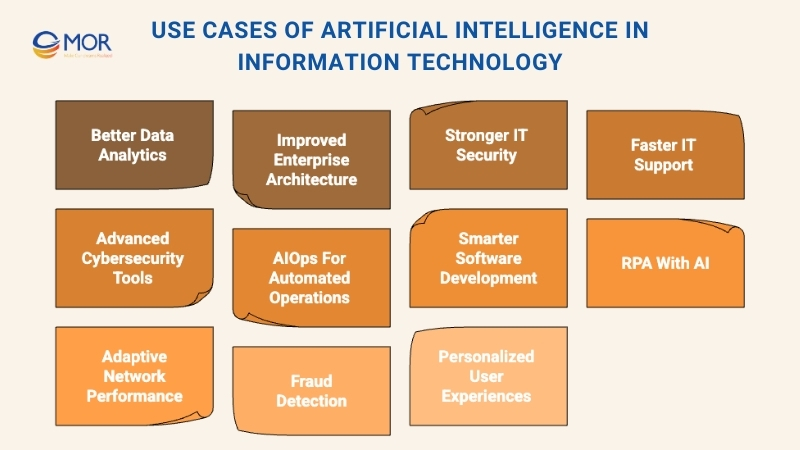
Better Data Analytics
AI models have changed how data analytics work today. They can study and process very large datasets in real time. This makes it easier to find useful patterns and insights that were difficult to detect before. These abilities give IT teams a stronger base for decisions that rely on real data.
They can also predict customer actions with more accuracy and improve their daily operations. This helps organizations stay competitive and gives them a stronger position in the market while using artificial intelligence technologies in management information system to support better data handling.
Improved Enterprise Architecture
AI also plays an important part in shaping enterprise architecture. Early forms of generative tools can already help teams create detailed documents for applications and research new technology options.
This gives enterprise architects more room to focus on harder tasks, including designing and setting up new systems. It also reduces the time needed for manual documentation work.
Neural graph networks and machine learning recommendation tools are also finding their place in enterprise AI platforms. They can study complex information and suggest clear steps that teams can follow to move projects forward.
Stronger IT Security
AI has raised the level of threat detection and protection in IT security. It can study network activity and spot possible risks at an early stage. This gives IT teams enough time to act before any harm happens.
For example, AI security tools can react on their own by blocking risky IP addresses or isolating devices that show signs of infection. This early action strengthens system defenses. It also lowers the pressure on IT staff and supports a safer and more stable working environment.
Faster IT Support
Enterprise AI chatbot development service and virtual assistants have changed how IT support works. These tools can answer user questions, fix simple issues, and provide quick help at any time. This reduces the load on human support teams and improves response speeds. It also helps build an IT support setup that can grow easily as the company expands, which fits the wider growth of AI in information technology across daily operations.
Advanced Cybersecurity Tools
Cyber threats continue to grow and become more complex, so strong protection is necessary. AI plays an important part in finding and stopping security breaches. These systems can study network activity and detect patterns that signal harmful actions. They can also act in real time to handle threats before they spread.
Machine learning models learn from earlier security events, which makes them better at stopping future attacks. This helps companies stay safer while dealing with a wide range of risks.
AIOps For Automated Operations
AIOps supports automation across major IT operations, including anomaly detection, event linking, and identifying root causes. According to research from SNS Insider, 63% of IT leaders foresee AIOps playing a crucial role in their IT operations in the coming years. This explains how central this approach is becoming.
This type of automation is important for handling modern IT environments. It also helps teams manage the large amount of data that these systems produce every day. AIOps reduces the time and effort needed to find and fix IT issues. This raises service quality and lowers downtime, supporting smoother operations within artificial intelligence in information technology.
Smarter Software Development And Testing
A recent Google survey found that 90% of developers now use AI at work and four in five say it makes them more productive. AI brings strong improvements to software development and testing. Tasks like automated code creation, bug detection, and performance tuning now happen faster with AI tools.
These abilities speed up the full development cycle. They also cut down on mistakes and help teams release high-quality products to the market with more confidence. This progress continues to shape how teams use artificial intelligence in information technology to improve engineering work.
RPA With AI For Process Automation
AI combined with robotic process automation can handle routine tasks that follow fixed rules. This raises overall efficiency and gives employees more time to focus on important work that needs human judgment.
Adaptive Network Performance
AI helps improve network performance by studying traffic patterns and adjusting settings based on changing workloads. These adjustments keep data flowing smoothly. This flexibility is key for stable performance in busy and fast-changing IT environments.
Fraud Detection And Prevention
AI strengthens fraud detection through pattern recognition and anomaly tracking. It can study behavior, spot activity that suggests fraud, and respond in real time. Machine learning models trained on older fraud records make this process even more accurate. These abilities help lower financial risk and build stronger trust with customers, which supports safer operations within artificial intelligence in information technology.
Personalized User Experiences
AI also helps create more personal experiences in IT tools and applications. It can study user actions and preferences to deliver content that matches each person’s needs. This type of targeted experience raises satisfaction and keeps users more engaged. It also supports the design of IT solutions that feel clearer, easier to use, and more intuitive.
Concerns About Artificial Intelligence In Information Technology
Understanding the risks linked to modern AI tools is an important part of working with artificial intelligence in information technology. These concerns shape how businesses plan, manage, and monitor their systems.
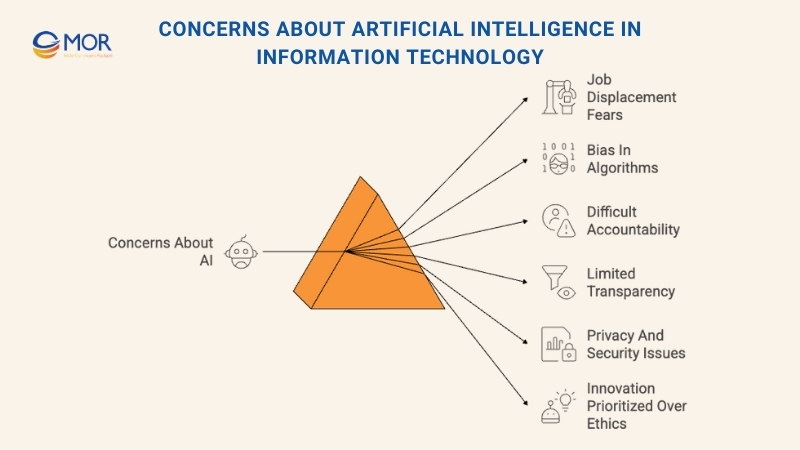
Job Displacement Fears
One major concern in the IT sector is the fear that AI could replace certain jobs. This worry often appears in roles that depend on reviewing or processing large amounts of data. Advanced devops AI tools can handle these tasks faster than people, and they can work without breaks. This leads some teams to question how these changes may affect roles and the impact of AI on it jobs in the future.
Bias In Algorithms
AI systems can also inherit bias from their training data. When this happens, the platform may deliver results that are inaccurate or unfair. Even when unintentional, these issues raise ethical questions and create challenges for organizations that rely on accurate outcomes.
Difficult Accountability
As AI becomes more common in IT systems, it becomes harder to determine who is responsible when something goes wrong. Some argue that companies should review the tools they use more carefully. Others believe the creators of those tools should be held accountable. This lack of clarity makes it difficult to pinpoint who is responsible for harmful results.
Limited Transparency
Some AI systems are built without a strong focus on openness, fairness, or long-term responsibility. When transparency is weak, the logic behind certain AI decisions becomes unclear. This creates risks for both users and businesses. Ethical development and responsible design become essential so the platform does not create hidden or harmful outcomes.
Privacy And Security Issues
AI can support better decision making, yet it also raises concerns around data safety. There is a higher chance of breaches or unauthorized access when sensitive information flows through advanced systems. Strong security practices are necessary to keep this information protected and maintain user trust.
Innovation Prioritized Over Ethics
In some cases, teams move fast to build new features, and ethical or security checks receive less attention. This can lead to AI systems entering the market without proper safeguards. When this happens, businesses face unnecessary risks, and trust in the technology can weaken.
How To Implement AI In Information Technology?
There is a clear path for bringing artificial intelligence in information technology into an organization. Each step helps teams build skills, plan practical uses, and apply AI in a way that supports long-term goals.
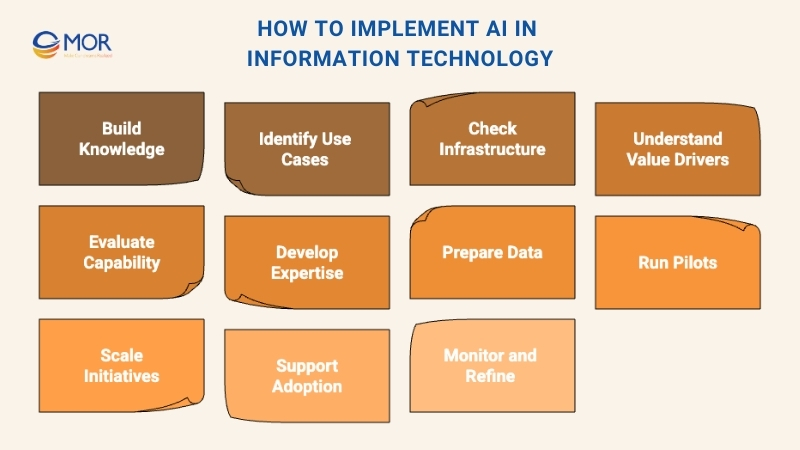
Build Foundational AI Knowledge
Start by learning what modern AI systems can do. Online classes and virtual workshops are a simple way to build this base. Platforms like EdX and Udacity provide both beginner and advanced lessons on areas like machine learning and predictive analytics. These resources help teams understand the basics so they can make informed decisions later.
Identify Valuable AI Use Cases
The next step is to explore where AI fits within your products or internal processes. It is important to identify situations where AI can solve problems or create clear value. This stage also includes setting specific goals for AI adoption, such as improving efficiency, strengthening security, or using resources more effectively. These targets guide the direction of future projects and support the wider use of AI in information technology within the business.
Check Current Infrastructure Readiness
A full review of your IT setup is important before moving forward. This review should look at your existing tools, the condition of your data, and the skill level of your team. Understanding these points shows how prepared your organization is to bring in AI.
Once your needs are clear, outline the direct business and financial gains that each AI project can bring. Each idea should link to real value. Keeping attention on short-term results helps demonstrate the impact of early AI work and supports wider adoption across artificial intelligence in information technology.
Understand Key Value Drivers
It is important to recognize the main factors that bring value, including better employee productivity. Think about whether AI can remove tasks that take too much time. A strong custom AI solution should fit smoothly into daily workflows. It should improve how your operations run and support long-term growth without causing disruption.
Evaluate Internal Capability
It is important to understand what your organization can handle before moving ahead with AI. This means looking at both your technical strength and your internal processes. A clear view of these areas helps you see what is already working and what needs improvement.
Finding gaps in capability may show the need for new tools or updates to current systems. Building on existing teams or ongoing projects can also support growth in certain business areas, especially as companies increase their use of artificial intelligence in information technology.
Develop Or Outsource AI Expertise
AI development requires skills that differ from traditional software work. It needs experts who understand how to build models that learn, think, and improve business processes. The work often includes advanced problem solving and deep experience with data.
Some companies may choose to outsource AI development to teams that specialize in big data, AI, or machine learning. These partners bring strong knowledge and a clear process. Their support can help avoid common mistakes during planning and development, which leads to better results.
Prepare And Process Data
Data works as the core of any AI system. It is important to make sure the right data is easy to access and ready for use. This includes checking past performance records and other key data sources that support training. These steps help build a strong base for any solution that relies on artificial intelligence in information technology.
After gathering the data, the next stage is cleaning and preparing it. This step removes errors and improves consistency. AI models depend on high-quality input, so proper preprocessing is essential for reliable results. Strong data leads to stronger outcomes.
Run Pilot Projects
Start with a small and controlled testing environment. This gives teams a clear view of how multimodal AI models behave in real situations. Short pilot phases, often two to three months, help teams stay focused on simple and realistic goals.
A small team of four or five people is usually enough to guide the pilot and keep progress steady. After this phase, the organization can decide how far the project can grow and whether a larger rollout is the right next step.
Scale AI Initiatives
A successful pilot gives the organization a clear path to expand AI projects. Teams should test how the system performs with fresh datasets and decide how well it fits into daily operations. This helps confirm whether the AI tools can handle real business demands at a larger scale.
As confidence grows, teams can move from small, low-risk projects to solutions with bigger goals. Lessons learned from early work guide better decisions. These first experiences help shape long-term plans for using artificial intelligence in information technology across more areas of the business.
Support Employee Adoption
It is important for employees to see AI as a tool that supports their work, not something that replaces them. Smooth adoption starts with involving key people in the process and helping them understand the changes. Clear training and steady support give teams the confidence to use AI systems in their daily tasks.
Monitor And Refine AI Models
Use monitoring tools to watch how AI systems perform in real time. Ongoing updates and improvements are necessary to keep models aligned with business needs. This also helps companies stay competitive as technology changes.
Teams should keep learning about new AI techniques and industry updates. Reviewing data strategies and AI tools from time to time ensures they continue to deliver value and support long-term growth.
Future Directions For AI In Information Technology
The future of artificial intelligence in information technology will continue to bring both opportunities and challenges. Privacy and security will stay major topics as AI grows stronger. As these systems advance, ongoing software development will be necessary to protect users and organizations.
There are also concerns about the environmental impact of training large AI models. Training requires high energy use, which increases the demand for cleaner and more efficient methods. This pushes the industry to find new ways to reduce the cost of AI on the environment, shaping the latest trends of information technology in artificial intelligence going forward.
The fast speed of AI development also means that ethical rules and regulatory standards must evolve. These guidelines will support safe use of AI tools. Education will continue to play an important role, helping future workers prepare for a world where AI sits at the center of most digital systems.
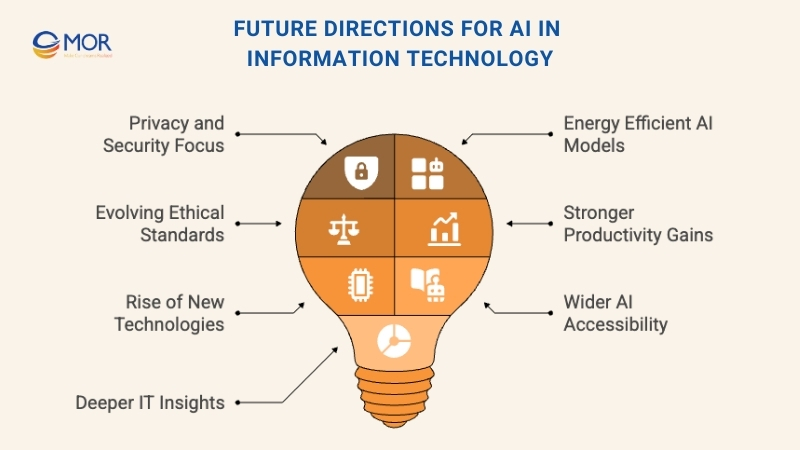
Even with these challenges, many benefits remain clear. AI can improve productivity in digital workspaces and help solve global problems, from climate pressures to healthcare gaps. Its growth inside IT services will cover simple tasks and complex work like network security. Yet skilled IT workers will still be needed. Their knowledge is important for building, guiding, and managing these systems to ensure responsible use and provide insights that AI cannot produce.
The rise of AI also connects with the arrival of other new technologies. Quantum computing, neuromorphic systems, and advanced robotics may shift attention in new directions while still working together with AI tools.
Leading companies such as Google and OpenAI will keep building platforms for customizable models. These tools will help teams create chatbots and other systems without the need for coding skills. This will make AI more accessible to more people.
IT teams will also rely on AI to study detailed records from employee interactions across channels like calls, emails, and CRM tools. These insights can guide decisions and improve product instructions to prevent mistakes.
This ongoing change shows why adaptability is important. Teams must stay flexible as technology expands and new forms of AI continue to shape the future of the tech industry.
Key Takeaways For Businesses Using AI In Information Technology
The rise of artificial intelligence in information technology represents a major change in how companies operate. AI strengthens IT governance and improves daily IT processes. These improvements show how widely AI can support the AI in tech environment and help businesses stay ahead.
These changes also help companies hold a strong position in a fast-moving market. AI in IT will continue to grow, and its influence will expand across many areas.
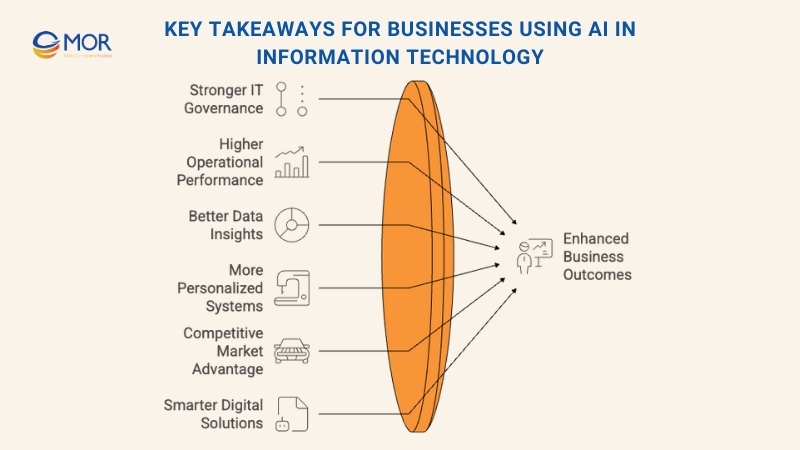
It can raise system performance, improve data analysis, and create more personal and accurate user experiences. These gains push companies to innovate and build smarter digital solutions.
Businesses that apply AI carefully and with clear goals gain a strong competitive edge. They can improve long-term stability and meet the demands of an increasingly digital world shaped by how is AI affecting the tech industry.
MOR Software JSC supports these goals through real, practical AI delivery. Our teams help companies turn AI ideas into working systems that scale. We improve data workflows and build solutions that match real business needs. With deep experience in mobile, web, and enterprise platforms, we help organizations use AI in a smart and strategic way so they can grow with confidence.
>>> Choosing the best AI development company can define how effectively a business uses artificial intelligence to grow, cut costs, and innovate. Let's dive in!
Conclusion
AI keeps reshaping how modern teams work, and companies that use artificial intelligence in information technology with clear goals gain the strongest advantage. It improves operations, sharpens decisions, and supports long-term growth across every layer of IT. MOR Software helps businesses turn these ideas into real solutions that scale with confidence. If you want smarter systems and better results, contact us to explore the next steps for your AI journey.
MOR SOFTWARE
Frequently Asked Questions (FAQs)
What is artificial intelligence in information technology?
Artificial intelligence in IT refers to using algorithms, models, and automated systems to perform tasks that usually require human decision-making. It helps IT teams manage data, detect issues, and improve system performance.
How is AI used in the information technology field?
AI supports IT teams by automating repetitive work, detecting security threats, managing large datasets, improving system monitoring, and helping teams make faster, data-based decisions.
How does AI help with cybersecurity in IT?
AI tools analyze network traffic, spot unusual behavior, and detect possible attacks much earlier than manual monitoring. This strengthens protection against malware, phishing attempts, and other threats.
What is the impact of AI on the IT sector?
AI is changing how IT teams work. Routine technical tasks are automated, which shifts the focus toward design, strategy, and high-level problem solving. Some roles evolve, while new AI-focused jobs open up across the industry.
Is AI replacing IT jobs?
AI automates certain tasks, but it also creates demand for new roles like data science, AI operations, and automation engineering. Instead of removing jobs outright, it reshapes the skills needed in IT.
How can IT departments start using AI?
Most teams begin by identifying manual tasks that slow operations. They then explore tools for automation, monitoring, analytics, and security, followed by testing small AI projects before expanding to larger systems.
What benefits does AI bring to IT operations?
AI improves accuracy, speeds up problem detection, reduces downtime, and gives teams real-time insights that help keep systems stable and efficient.
Can AI help with software development?
Yes. AI can review code, suggest improvements, detect bugs, automate testing, and help developers work faster by taking over repetitive parts of the workflow.
How does AI support data management in IT?
AI can collect, organize, and analyze huge amounts of data. It highlights patterns, trends, and risks that might be too complex or time-consuming for manual analysis.
What role does AI play in IT support services?
AI chatbots and virtual assistants respond to common questions, troubleshoot simple issues, and guide users. This reduces wait times and improves the support experience.
What are common examples of AI in enterprise IT?
Examples include predictive analytics platforms, automated monitoring systems, AIOps tools, smart security systems, code-review assistants, and NLP-based helpdesk bots.
What challenges come with adding AI to IT systems?
Organizations often face issues like poor data quality, high implementation costs, integration difficulties, and the need for staff training. Clear planning and pilot testing usually help reduce these hurdles.
Rate this article
0
over 5.0 based on 0 reviews
Your rating on this news:
Name
*Email
*Write your comment
*Send your comment
1